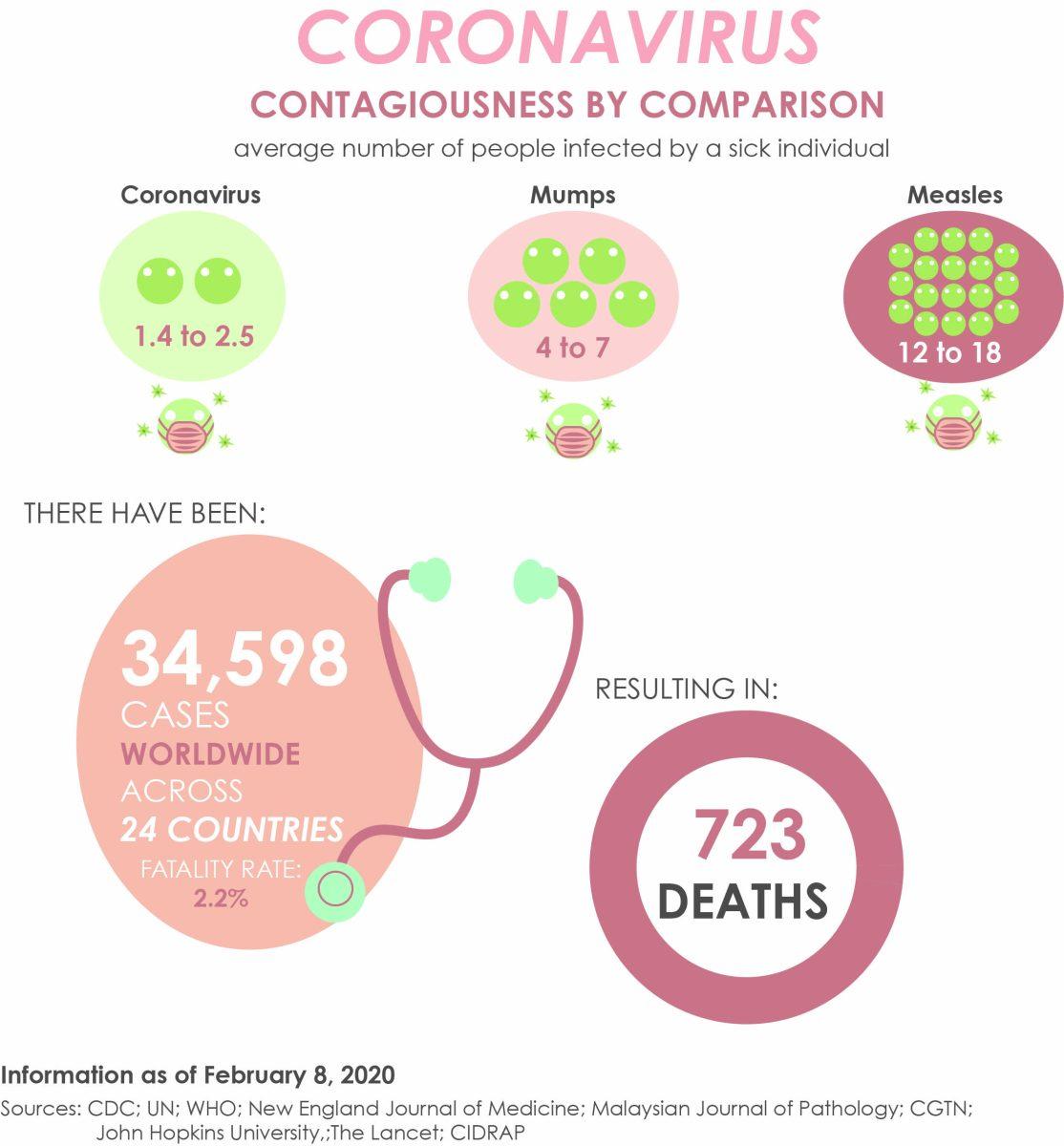
Graphic by Alesandra Bell | Mercury Staff
Recent reports estimate over 34,000 cases of coronavirus
worldwide, with 0.0003% of those cases in the U.S. Despite the low case rate,
media coverage of the virus has sparked nationwide concern.
Coronavirus refers to a family of viruses usually found in
animals that are also responsible for the common cold. The latest strain, 2019
novel coronavirus or 2019 nCoV, made the jump from an animal carrier to a human
host in December in Wuhan, China. The first case was reported Dec. 1 and has
led to 723 deaths, giving it a fatality rate of approximately two percent. This
makes 2019 nCoV less than half as deadly as Severe Acute Respiratory Syndrome,
a different strain of coronavirus that first appeared in 2002. Associate
professor of biology John Burr said that the 2019 nCoV’s genome has a unique
feature that makes it less harmful than originally thought.
“It turns out the coronavirus genome is quite large. The
coronavirus RNA polymerase can actually do what DNA polymerase does,” Burr
said. “If it makes a mistake, it can be detected and go back and correct it and
then continue on again.”
Polymerases are enzymes used to replicate genetic
information. RNA polymerases are error-prone, which means they make errors
during replication which lead to mutations that can make viruses more deadly.
Unlike most RNA polymerases, the 2019 nCoV’s polymerase has an editing
function, minimizing mutations and decreasing the chances of the virus becoming
more deadly.
The 2019 nCoV is believed to have spread from Wuhan’s food
markets and originated from a bat. While bats aren’t commonly eaten in Wuhan,
they are known carriers of disease and can spread diseases to other animals,
which are eventually consumed. Burr said that viruses typically use a host’s
immune system to eventually kill them.
“It’s often not so much that a virus that kills you, but
your own immune system kills you. It’s called a cytokine storm,” he said. “Some
viruses, especially the 1917 Spanish flu that killed so many people, really
super-activated the immune system and it was the inflammatory response of the
immune system, all those cytokines that actually was lethal. So, I suspect
that’s gonna turn out to be true for coronaviruses.”
Bats have a natural ability to suppress the inflammatory
response normally activated by viruses, which is why they’re such good hosts.
They allow the virus to maintain the ideal environment to replicate and spread
without killing the host. Despite the sizable death toll, 2019 nCoV has killed
far less people than the flu. The CDC estimates 12,000 deaths occur from the
flu every year in the U.S. alone. Burr said that the widespread concern over
2019 nCoV despite the existence of deadlier diseases isn’t abnormal.
“It’s just human nature. I mean, would you not be a little
bit iffy? I wouldn’t go to campus today if we knew that there was a massive
outbreak of the newest strain of flu going around on campus here,” he said.
“Probably not going to kill you if you get infected, but it’s a damn unpleasant
experience to go through.”
The spread of the virus has led to criticisms of Chinese
cuisine and increased racism toward Asian people in general. UC Berkeley came under
fire for listing xenophobia as a common reaction to the 2019 nCoV. Several
posts on social media, including the UTD subreddit, have made jokes about
avoiding or fearing Chinese people. Assistant professor of instruction of
sociology John Malek-Ahmadi said ethnocentrism, or a sense of cultural
superiority may be part of the problem.
“Although there’s plenty of Americans who eat Chinese food
and Japanese food or all sorts of Asian cuisine, they’ll make excuses for it
and say, ‘Well, that’s not our food.’ And so when something’s wrong with it, or
you know, there’s an outbreak like this, it’s easy for people to say,
‘Oh, well that’s, that’s something caused by other folks,’”
he said. “It’s kind of the ‘othering’ process takes place wherein if you have a
virus like this one that has originated in a particular country, it’s really
easy for people many miles away to ‘other’ them, to dehumanize people and to
treat them negatively as a consequence of that. Because they’re not really
seeing the humanity in it.”
Malek-Ahmadi said people are so quick to label certain
groups of people as “other” due to tribal instincts despite the fact that there
are more genetic similarities across races than within them. Media
sensationalism also has a role to play in public reactions by causing
widespread concern, he said.
“You’re scrolling through your feed on your phone and you’re
seeing stories about this coronavirus. You’re hearing it on the news, maybe
people are talking about it, certain circles at work and when it becomes sensationalized,
of course it seems like it’s a bigger deal than it actually is,” he said.
“Then, of course when people are scared, they tend to act irrationally and
they’ll go back to those baser instincts. And that’s where you’re probably
getting the racist comments from.”
The incubation period for the virus is about 14 days and
2019 nCoV is actually less contagious than the flu. No deaths have occurred
from the virus in the U.S. and no confirmed cases have been reported in Texas.